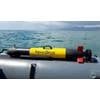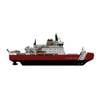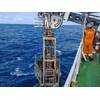Inside the Subsea Cable Firm Secretly Helping America Take on China
On Feb. 10 last year, the cable ship CS Dependable appeared off the coast of the island of Diego Garcia, an Indian Ocean atoll that’s home to a discreet U.S. naval base.
Over the next month, the ship’s crew covertly laid an underwater fiber-optic cable to the military base, an operation code-named “Big Wave,” according to four people with direct knowledge of the mission, as well as a Reuters analysis of satellite imagery and ship tracking data.
The new super-fast internet link to Diego Garcia, which has not previously been reported, will boost U.S. military readiness in the Indian Ocean, a region where China has expanded its naval influence over the last decade.
The CS Dependable is owned by SubCom, a small-town New Jersey cable manufacturer that’s playing an outsized role in a race between the United States and China to control advanced military and digital technologies that could decide which country emerges as the world’s preeminent superpower.
SubCom, a company born out of a U.S. Cold War project to spy on Soviet submarines, is living a double life.
Publicly, it is one of the world’s biggest developers of undersea fiber-optic cables for telecom firms and tech giants like Alphabet’s Google, Amazon, Microsoft and Meta Platforms.
Behind the scenes, SubCom is the exclusive undersea cable contractor to the U.S. military, laying a web of internet and surveillance cables across the ocean floor, according to the four people with knowledge of the matter: two SubCom employees and two U.S. Navy staffers. The individuals asked not to be named because they were not authorized to discuss the operations.
This dual role has made SubCom increasingly valuable to Washington as global internet infrastructure – from undersea cables to data centers and 5G mobile networks – risks fracturing into two systems, one backed by the United States, the other controlled by China.
SubCom is owned by Cerberus Capital Management, a New York-based private equity firm that has invested in defense contractors and national security assets. Last year, Cerberus paid $300 million for a Philippine shipyard on a former U.S. Navy base close to the South China Sea, beating out Chinese competitors for control of a strategic site in a region where Beijing has been flexing its military muscle.
Cerberus is headed by Stephen Feinberg, a billionaire political donor whom former President Donald Trump drafted onto the President’s Intelligence Advisory Board, which counsels the commander-in-chief on U.S. foreign intelligence matters.
SubCom, Cerberus and Feinberg did not respond to requests for comment.
Presented with Reuters’ findings, a spokesperson for the U.S. Navy’s Pacific Fleet confirmed the existence of a new high-speed undersea internet cable to Diego Garcia. It was the first official acknowledgement of that cable.
“The resiliency, redundancy, and security of our communication infrastructure represents a top priority for U.S. Pacific Fleet,” the spokesperson said in an emailed statement.
The statement said the Navy could not discuss specifics for operational security reasons. The Navy did not respond to Reuters’ questions about SubCom or name the company in its statement.
SubCom’s journey from Cold War experiment to global cable constructor and now a shadowy player in the U.S.-China tech war is detailed in this story for the first time.
Reuters is revealing details of the Diego Garcia project and SubCom’s deepening ties with the Pentagon. The news agency is also the first to report on a confidential contract the company secured from tech giant Google to build the world’s largest private undersea internet network.
That partnership is the kind of America Inc project that President Joe Biden has been calling for in his drive to promote U.S. advanced technologies.
Google did not respond to requests for comment.
Undersea cables transmit 99% of all transcontinental internet traffic, including instant messenger chats, stock market transactions and military secrets. This underwater network has become one of the key weapons in the U.S.-China tech war, as detailed in a Reuters investigation published in March. Subsea cables are vulnerable to sabotage and espionage, and Beijing and Washington have accused each other of tapping cables to spy on data or carry out cyberattacks.
SubCom’s increasing importance to the United States can be split into two categories, one military and one economic, according to two subsea cable industry officials who have worked on U.S. government projects.
First, Washington needs SubCom to expand the Navy’s undersea cable network so that it can better coordinate military operations and enhance surveillance on China’s expanding fleet of submarines and warships, the people said. Second, the Biden administration wants SubCom to build more commercial subsea internet cables controlled by U.S. companies, a strategy aimed at ensuring that America remains the primary custodian of the internet, according to the two industry officials.
SubCom operates six cable-laying ships: bespoke deep-sea vessels fitted with vast storage drums to hold sheaves of fiber-optic cable. The Navy has only one such ship – the 40-year-old USNS Zeus – a vessel so old that it is limited to carrying out repairs, according to Eckhard Bruckschen, director of the UK-based Undersea Cable Consultancy.
“SubCom is indispensable to America if it wants to control subsea cables. They’ve got no one else,” Bruckschen told Reuters.
There are only four major companies in the world that manufacture and lay subsea cables: America’s SubCom, Japan’s NEC Corporation, France’s Alcatel Submarine Networks and China’s HMN Tech.
For sensitive U.S. projects, Washington only works with SubCom, according to five industry sources who have worked on projects with the cable company.
The U.S. Department of Defense and the White House did not respond to requests for comment.
Picking sides
Until a U.S. crackdown on Chinese tech companies ramped up five years ago, SubCom laid cables for telecom and tech companies worldwide, including the big state-owned Chinese carriers.
Not anymore. The cable firm now works almost exclusively for the U.S. military and big U.S. tech firms, two SubCom employees told Reuters.
SubCom’s pivot reflects a sea change underway in the internet infrastructure industry, which has long seen choosing sides in great-power politics as bad for business. But U.S. sanctions on Chinese tech companies and an increase in trade-protectionist policies under Biden and his predecessor Trump have forced American tech firms to work mainly with companies and countries viewed as friendly to the United States.
The U.S. Department of Justice in 2020 blocked Google, Meta and Amazon from building fiber-optic cables from the United States to Hong Kong due to concerns about Chinese spying.
Microsoft – whose President Brad Smith said in 2017 that the tech sector needed to be a “neutral digital Switzerland” – announced in May that it had discovered Chinese state-sponsored hackers targeting U.S. critical infrastructure, a rare example of a big tech firm calling out Beijing for espionage. China’s Foreign Ministry spokesperson Mao Ning said at the time that the accusations were part of a U.S. disinformation campaign, describing America as the “empire of hacking.”
In December of last year, the Pentagon awarded $9 billion worth of Cloud computing contracts to Google, Amazon, Microsoft and Oracle, entrusting these companies to keep America’s most closely held secrets under digital lock and key.
“Silicon Valley is waking up to the reality that it has to pick a side,” said Jacob Helberg, former head of Google’s news policy and a member of the U.S.-China Economic and Security Review Commission, a government agency.
Google did not respond to a request for comment. Amazon, Microsoft and Oracle declined to comment.
SubCom’s loyalty is especially important because it is the only major U.S. subsea cable company. Headquartered in the quiet borough of Eatontown, New Jersey, SubCom secured a $10 million-a-year contract in 2021 from the U.S. Department of Transportation (DOT) to run a two-vessel fleet to provide undersea cable security, according to one SubCom employee and one Navy staffer with knowledge of the deal. A 2020 DOT notice to prospective applicants said winners would be responsible for laying, maintaining and repairing subsea cables to support U.S. national security and economic interests, in partnership with the Department of Defense.
The SubCom ships CS Dependable and CS Decisive now make up the U.S. government’s first Cable Security Fleet, the people said.
The DOT and SubCom did not respond to requests for comment.
Operation ‘Big Wave’
One of CS Dependable’s destinations was Diego Garcia, a horseshoe-shaped atoll which hosts U.S. aircraft carriers and submarines, and has an airfield capable of landing long-range bombers.
Located in the heart of the Indian Ocean, Diego Garcia is a British overseas territory. Since the 1970s, Britain has allowed the United States to operate a naval base there. The island is currently home to around 3,000 people, including Navy sailors, family members and support staff, two people who have worked on the atoll told Reuters, speaking on condition of anonymity. Diego Garcia boasts shops, restaurants, bars and pristine beaches, the people said.
Prior to the laying of the new subsea cable, the island base accessed the internet via satellites, which are slower and less reliable than cables, the two people said.
The CS Dependable’s clandestine underwater operation on Diego Garcia was never mentioned publicly by participants in the business deal that made it happen. Rather, they carefully obscured the U.S. military component within a larger private-sector cable project, according to four subsea cable industry sources with knowledge of the arrangement.
In 2020, SubCom announced that it had been commissioned by an Australian tech mogul to lay a $300 million commercial internet cable from Australia to the Sultanate of Oman on the Arabian Peninsula, a route that traverses the Indian Ocean.
That project, known as the Oman Australia Cable, was spearheaded by SUBCO, a Brisbane-based subsea cable investment company owned by Australian entrepreneur Bevan Slattery.
The industry was skeptical about the commercial viability of the route, given it would mostly serve a small pool of Australian telecom firms that already had access to multiple cables running through Southeast Asia to the Middle East, five industry sources told Reuters.
What many of them didn’t know was that the Pentagon had paid for around a third of the entire cable on the condition that it include a splice connecting its commercial trunk to Diego Garcia, two of the people with knowledge of the project told Reuters.
The U.S. Pacific Fleet, in its statement to Reuters, said SUBCO’s Oman Australia Cable offered “a unique opportunity” to connect the remote island with an undersea fiber-optic internet cable.
The statement said the U.S. Pacific Fleet partnered with companies laying the Oman Australia Cable to extend a branch to Diego Garcia, but did not disclose how much it paid for the spur.
“This partnership has increased the digital resiliency and security of our communication infrastructure in the Indo-Pacific,” the statement said.
While the Navy had said nothing officially about the cable until now, sailors on Diego Garcia were tipped off last year. Captain Richard Payne, then-commander on Diego Garcia, mentioned the cable during a Feb. 9 guest appearance on the base’s local radio station, “99.1 The Eagle,” a recording of which was posted on the Navy radio station’s Facebook page.
Payne, who was fielding questions submitted by listeners, volunteered that an unusual vessel could be sighted off the western shore of Diego Garcia.
“We’re going to have fiber optics here on the island very soon,” Payne told the program’s host, Alex Kerska or “DJ Special K,” during the segment in which he also addressed complaints about high beer prices on the atoll and called on island residents to attend a kickball tournament.
“Starting today (or) tomorrow, we have the cable-laying ship that is out there off the coast now. It’s a commercial company doing that … It’s a very interesting ship,” Payne continued, without naming the company or the ship.
Payne, who now works in the office of the Under Secretary of Defense for Intelligence and Security, did not respond to a request for comment.
The ship Payne was referring to was the CS Dependable, according to the SubCom and Navy sources with knowledge of the operation.
SubCom’s CS Reliance vessel laid the first half of the commercial cable from Perth, Australia, to the middle of the Indian Ocean. From there, the CS Dependable took over, running the splice to Diego Garcia and laying the rest of the main trunk up to Oman, the people said.
Reuters analyzed satellite images and ship tracking data on Eikon, the financial analysis platform owned by the London Stock Exchange Group. That information showed the CS Dependable operating around Diego Garcia in February and March of 2022, then sailing on to Oman.
The delicate operation was made possible by a decades-long friendship between three veterans of the subsea cable industry, according to two people with knowledge of the dealings.
Coordinating the Pentagon’s end was Catherine Creese, a former U.S. Coast Guard officer who is now Director of the U.S. Naval Seafloor Cable Protection Office, the unit that oversees the Navy’s subsea cables.
Prior to joining the Navy in 2006, Creese worked at SubCom for 11 years, a time when it was known as Tyco Telecommunications. There she worked closely alongside the man who is now SubCom’s CEO, David Coughlan, according to two former SubCom employees who worked with Coughlan and Creese.
Coughlan and Creese planned and executed the Diego Garcia operation, according to one current SubCom employee and one Navy staffer.
Creese and Coughlan did not respond to requests for comment. The U.S. Navy did not respond to questions about Creese’s involvement.
‘Dreams come true’
Selling the cable to investors, meanwhile, was the purview of Slattery, the Australian entrepreneur, who has made a fortune building and selling private undersea cables. In a conservative industry, the businessman stands out as a gregarious and outspoken character who is willing to take on risky projects, according to three industry sources who have worked with Slattery.
Slattery did not respond to requests for comment.
SubCom’s Coughlan helped Slattery pull off his first major cable deal in the late 2000s, setting him on course to become one of Australia’s wealthiest tech moguls, according to two industry sources with knowledge of the matter.
That project, a SubCom-built cable running between Brisbane and Guam, a U.S. Pacific island territory that’s also home to a naval base, almost bankrupted Slattery, the businessman told the Australian Financial Review in a 2016 interview.
Thanks to sympathetic suppliers, Slattery got that cable, known as PIPE, over the line, according to the Financial Review article. Crucially, SubCom, the main supplier on the project, extended Slattery credit to get the cable finished, the two industry sources said.
Slattery sold the company that owned the PIPE cable for A$373 million ($248 million) in 2010, the first of a string of successful tech infrastructure bets. Slattery has a personal net worth of A$564 million ($375 million), according to a 2020 “Rich List” published by the Financial Review.
The entrepreneur pitched the Oman Australia Cable in public statements as an alternative to the traditional route between Australia and the Middle East that passes through Southeast Asia. The spur to Diego Garcia was never mentioned.
A blueprint for such a project already existed. Slattery’s cable was essentially a revival and rerouting of a 2017 plan to build a cable between Australia and the Republic of Djibouti on the Horn of Africa, with a secret link to Diego Garcia funded by the Pentagon, according to a person directly involved in that deal. Djibouti is the site of China’s first-ever overseas military base, which opened in 2017.
The earlier proposed cable – known as the Australia West Express – was never built because the U.S. company behind the project, GoTo Networks, couldn’t secure the private investment needed to cover the portion not funded by the Pentagon, the person said.
John Mariano, who was the CEO of the now-defunct GoTo Networks, declined to comment. The U.S. Department of Defense did not respond to a request for comment. An official from the president’s office in Djibouti declined to comment.
Cables are typically owned by a consortium of telecom and tech companies that spread the cost and risk. Occasionally, entrepreneurs or private equity firms build a cable on spec with the aim of selling bandwidth to carriers and tech companies before flipping the cable for a profit.
Slattery is a master of such deals, two people who worked with him told Reuters. He used his experience and contacts to attract enough investors to supplement the Pentagon funding to get the Oman Australia Cable built, the two people said.
The 10,000-kilometer cable was officially opened by Australian Prime Minister Anthony Albanese in October 2022. It includes a splice to the Cocos Islands, an Australian territory which comprises a cluster of tiny islands between Sri Lanka and Australia. Australia’s military has been seeking parliamentary approval for funds to upgrade an airfield there and make other improvements aimed at strengthening its maritime surveillance capabilities in the region.
Slattery on Nov. 19, 2022, tweeted a group photo that included himself and Albanese, both with broad grins, celebrating the cable and the team that made “dreams come true.”
Albanese’s office did not respond to a request for comment about the project, its funding or potential military uses. In an Oct. 22, 2022, tweet sent from his Twitter account, he lauded the cable’s speed, security and reliability, and boasted that it could stream “over 65 million Netflix shows simultaneously.”
The government of Oman did not respond to a request for comment.
Levers of power
SubCom’s role in the project marked a return to its Cold War roots.
The company was founded in 1955, according to its website, the year the first subsea transatlantic telephone cable system was laid between Scotland and Newfoundland. That cable was deployed by AT&T’s submarine cable unit, which would eventually become SubCom.
The true origins of AT&T’s subsea cable business go back five years earlier, when the company was commissioned by the U.S. Navy to build a network of undersea surveillance cables to listen for Soviet submarines, according to three former employees with knowledge of the matter.
The project was known as the Sound Surveillance System, or “Project Caesar,” according to a declassified document about the program available on the U.S. Navy’s website. The document does not mention AT&T’s involvement.
Once the Navy project was complete, AT&T’s submarine cable project morphed into a commercial business, the former employees said.
AT&T did not respond to a request for comment.
In 1997, AT&T sold its cable-laying operation, including a fleet of ships, to Tyco International, a security company based in New Jersey. In 2018, Tyco sold the cable unit, by this time dubbed TE SubCom, for $325 million to Cerberus, the New York private equity firm.
SubCom doesn’t make public many details about its business. The company has more than 1,300 employees and an annual revenue of $344 million, according to data on Eikon.
Last year, SubCom signed a “master service agreement” with Google, one of the world’s biggest investors in subsea internet cables, according to two people with knowledge of the deal.
That contract, which the people said is worth hundreds of millions of dollars, could help Google build the world’s largest-ever private data network, connecting Cloud data centers around the world with a web of SubCom-manufactured undersea cables.
Google did not respond to a request for comment.
More undersea cables and data centers in the hands of U.S. companies like Google and SubCom is a win for Washington as it seeks to keep Chinese firms away from the internet hardware that will underpin global economic and military progress for decades to come, said Kellee Wicker, director of the Science and Technology Innovation Program at the Wilson Center, a Washington-based think tank.
“Cables are an enormous lever of power,” Wicker said. “If you can’t control these networks directly, you want a company you can trust to control them.”
(Reuters - Reporting by Joe Brock; Additional reporting by Phil Stewart, John Mair and Maha El Dahan; Editing by Marla Dickerson)













 December 2025
December 2025



